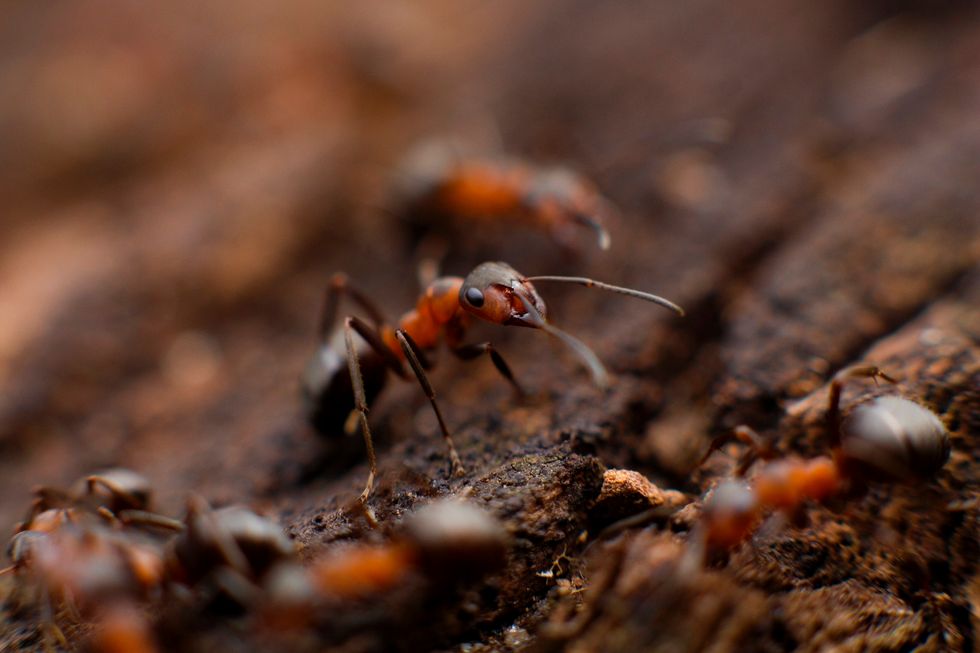Ants. You see them everywhere: marching in unison on your picnic spread, congregating on their mighty hills, or treading aimlessly in search of food. We rarely notice these critters scurrying beneath our feet (in some cases above our heads), but ants are the most populous insect in the world.
To put it into perspective, if we were to measure and add the weight of all humans on the planet, we still would only compose a fraction of the mass of all ants. If the average mass of ants is 1 to 5mg and the average mass of a human is 70kg, it would take approximately 23,333,333 ants to match that weight. Just as civilization was an emergent property of all the people in the community, the social structure that emerges from the sum of an ant colony is fascinating.
Ants tend to fall under five major subdivisions, compartmentalizing in order to conduct a specific task for the colony: the queen, worker, soldier, princess, and drone. The queen is the ant that creates the colony, laying thousands of eggs every day. If it weren't for the queen, the ant colony would collapse in a matter of days if not replaced. The queen has one of the highest average lifespans of insects, ranging between 1 and 30 years.
The worker ants make up a majority of the ant population and are composed of sterile female ants. Smallest in size, these ants are given most of the colony's responsibilities: tending to the queen and brood, searching for food, and expanding the nest as a whole. They tend to live anywhere between a month to 5 years.
Soldier ants, noted by their large heads, protect the colony from larger predators while carrying objects. These soldiers are also sterile females, using their strength and mandibles to also assist in the harvest. The soldier ants are essentially larger workers and are also known as the "major workers." Both of these ants can hoist anywhere between 10 to 50 times their bodyweight and move 800 times its body length a minute. A human with such proportional strength could lift between 900 and 4500 KILOGRAMS and move 80 feet per SECOND. Talk about world class athletes!
These workers can pile onto one another and form rafts and bridges in order to expand their colonies in search of resources. The unity between these ant units is what allows them to travel vast distances for the sake of expanding the colony.
The princesses and drones are both alate flying ants responsible for the founding of new queens. Once the princess is fertilized, they clip their wings in order to feed the broods. The drones are the only males in the colony and die shortly after mating. The drones may only live for a few months, but their one purpose is crucial for the colony's survival.
The nuptial flight is when the alates mate. The female releases pheromones to attract the males, eluding them to select the strongest one. After they mate, the female would land and begin her journey as a queen.
The way roles are assigned to different ants relies solely on probability. When two workers come in to contact with one another, they release pheromones that define their task: if they're harvesting food, caring for larvae, etc. Then the ants go their separate ways if they aren't doing the same job. The worker keeps track of each encounter, recognizing if there is an understaffed niche that needs to be filled. They then release pheromones to notify other ants that they changed their job. This process is governed by serendipity; random chance decides the colony's fate.
Because tens of thousands of ants compose the colony, or rather, the sample size is extremely large, you can apply the Law of Large Numbers. As the sample size of a chance experiment increases, the probability for the desired outcome will get closer and closer to its true value.
Let's say there are 4 jobs that the worker ant could undertake: harvesting, caretaking, building, and patrolling. The probability for selecting a harvester is 1/4, a caretaker 1/4, and so on. What the Law of Large Numbers states is that when we select a larger number of these ants, such as 10,000, then the proportion of ants that are caretakers would be close to 1/4 (in this case 2,500 would be caretakers.) In turn, because there are so many ants in just one colony, one can be assured that the roles would be distributed fairly equally among the workers due to a mathematical concept!
Although these little critters may give some the heebie-jeebies, ants fill one of the most unique niches in the animal kingdom. Their complex social structure became the key to their survival on Earth. Ants are able to emulate a simplistic task of the social structures of human civilization; construction and carpentry are in tandem with worker ants who expand the colony and build ant hills; babysitters and mothers care for children; harvester ants play the role farmers do in our society.
Now, this is to be taken with a grain of salt; the complexity of the human mind allows for literally thousands of careers under which we compartmentalize. But it's marvelous to witness unique structures in another creature, even if the complexities aren't as synonymous.
















